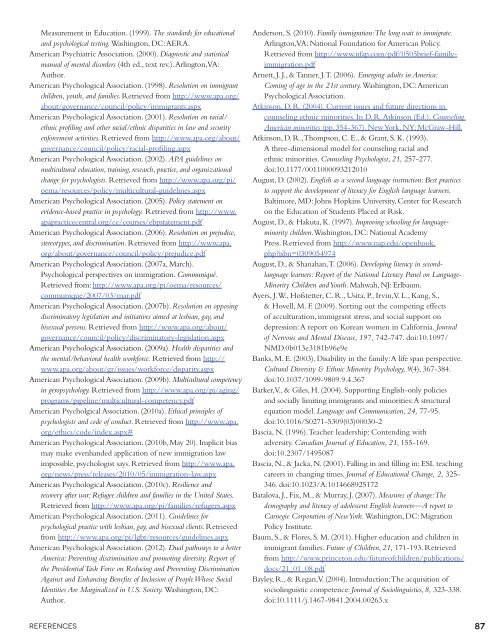Crossroads: The Psychology of Immigration in the New Century
Crossroads: The Psychology of Immigration in the New Century
Crossroads: The Psychology of Immigration in the New Century
You also want an ePaper? Increase the reach of your titles
YUMPU automatically turns print PDFs into web optimized ePapers that Google loves.
Measurement <strong>in</strong> Education. (1999). <strong>The</strong> standards for educational<br />
and psychological test<strong>in</strong>g. Wash<strong>in</strong>gton, DC: AERA.<br />
American Psychiatric Association. (2000). Diagnostic and statistical<br />
manual <strong>of</strong> mental disorders (4th ed., text rev.). Arl<strong>in</strong>gton, VA:<br />
Author.<br />
American Psychological Association. (1998). Resolution on immigrant<br />
children, youth, and families. Retrieved from http://www.apa.org/<br />
about/governance/council/policy/immigrants.aspx<br />
American Psychological Association. (2001). Resolution on racial/<br />
ethnic pr<strong>of</strong>il<strong>in</strong>g and o<strong>the</strong>r racial/ethnic disparities <strong>in</strong> law and security<br />
enforcement activities. Retrieved from http://www.apa.org/about/<br />
governance/council/policy/racial-pr<strong>of</strong>il<strong>in</strong>g.aspx<br />
American Psychological Association. (2002). APA guidel<strong>in</strong>es on<br />
multicultural education, tra<strong>in</strong><strong>in</strong>g, research, practice, and organizational<br />
change for psychologists. Retrieved from http://www.apa.org/pi/<br />
oema/resources/policy/multicultural-guidel<strong>in</strong>es.aspx<br />
American Psychological Association. (2005). Policy statement on<br />
evidence-based practice <strong>in</strong> psychology. Retrieved from http://www.<br />
apapracticecentral.org/ce/courses/ebpstatement.pdf<br />
American Psychological Association. (2006). Resolution on prejudice,<br />
stereotypes, and discrim<strong>in</strong>ation. Retrieved from http://www.apa.<br />
org/about/governance/council/policy/prejudice.pdf<br />
American Psychological Association. (2007a, March).<br />
Psychological perspectives on immigration. Communiqué.<br />
Retrieved from: http://www.apa.org/pi/oema/resources/<br />
communique/2007/03/mar.pdf<br />
American Psychological Association. (2007b). Resolution on oppos<strong>in</strong>g<br />
discrim<strong>in</strong>atory legislation and <strong>in</strong>itiatives aimed at lesbian, gay, and<br />
bisexual persons. Retrieved from http://www.apa.org/about/<br />
governance/council/policy/discrim<strong>in</strong>atory-legislation.aspx<br />
American Psychological Association. (2009a). Health disparities and<br />
<strong>the</strong> mental/behavioral health workforce. Retrieved from http://<br />
www.apa.org/about/gr/issues/workforce/disparity.aspx<br />
American Psychological Association. (2009b). Multicultural competency<br />
<strong>in</strong> geropsychology. Retrieved from http://www.apa.org/pi/ag<strong>in</strong>g/<br />
programs/pipel<strong>in</strong>e/multicultural-competency.pdf<br />
American Psycholgical Association. (2010a). Ethical pr<strong>in</strong>ciples <strong>of</strong><br />
psychologists and code <strong>of</strong> conduct. Retrieved from http://www.apa.<br />
org/ethics/code/<strong>in</strong>dex.aspx#<br />
American Psychological Association. (2010b, May 20). Implicit bias<br />
may make evenhanded application <strong>of</strong> new immigration law<br />
impossible, psychologist says. Retrieved from http://www.apa.<br />
org/news/press/releases/2010/05/immigration-law.aspx<br />
American Psychological Association. (2010c). Resilience and<br />
recovery after war: Refugee children and families <strong>in</strong> <strong>the</strong> United States.<br />
Retrieved from http://www.apa.org/pi/families/refugees.aspx<br />
American Psychological Association. (2011). Guidel<strong>in</strong>es for<br />
psychological practice with lesbian, gay, and bisexual clients. Retrieved<br />
from http://www.apa.org/pi/lgbt/resources/guidel<strong>in</strong>es.aspx<br />
American Psychological Association. (2012). Dual pathways to a better<br />
America: Prevent<strong>in</strong>g discrim<strong>in</strong>ation and promot<strong>in</strong>g diversity. Report <strong>of</strong><br />
<strong>the</strong> Presidential Task Force on Reduc<strong>in</strong>g and Prevent<strong>in</strong>g Discrim<strong>in</strong>ation<br />
Aga<strong>in</strong>st and Enhanc<strong>in</strong>g Benefits <strong>of</strong> Inclusion <strong>of</strong> People Whose Social<br />
Identities Are Marg<strong>in</strong>alized <strong>in</strong> U.S. Society. Wash<strong>in</strong>gton, DC:<br />
Author.<br />
References<br />
Anderson, S. (2010). Family immigration: <strong>The</strong> long wait to immigrate.<br />
Arl<strong>in</strong>gton, VA: National Foundation for American Policy.<br />
Retrieved from http://www.nfap.com/pdf/0505brief-familyimmigration.pdf<br />
Arnett, J. J., & Tanner, J. T. (2006). Emerg<strong>in</strong>g adults <strong>in</strong> America:<br />
Com<strong>in</strong>g <strong>of</strong> age <strong>in</strong> <strong>the</strong> 21st century. Wash<strong>in</strong>gton, DC: American<br />
Psychological Association.<br />
Atk<strong>in</strong>son, D. R. (2004). Current issues and future directions <strong>in</strong><br />
counsel<strong>in</strong>g ethnic m<strong>in</strong>orities. In D. R. Atk<strong>in</strong>son (Ed.), Counsel<strong>in</strong>g<br />
American m<strong>in</strong>orities (pp. 354-367). <strong>New</strong> York, NY: McGraw-Hill.<br />
Atk<strong>in</strong>son, D. R., Thompson, C. E., & Grant, S. K. (1993).<br />
A three-dimensional model for counsel<strong>in</strong>g racial and<br />
ethnic m<strong>in</strong>orities. Counsel<strong>in</strong>g Psychologist, 21, 257-277.<br />
doi:10.1177/0011000093212010<br />
August, D. (2002). English as a second language <strong>in</strong>struction: Best practices<br />
to support <strong>the</strong> development <strong>of</strong> literacy for English language learners.<br />
Baltimore, MD: Johns Hopk<strong>in</strong>s University, Center for Research<br />
on <strong>the</strong> Education <strong>of</strong> Students Placed at Risk.<br />
August, D., & Hakuta, K. (1997). Improv<strong>in</strong>g school<strong>in</strong>g for languagem<strong>in</strong>ority<br />
children. Wash<strong>in</strong>gton, DC: National Academy<br />
Press. Retrieved from http://www.nap.edu/openbook.<br />
php?isbn=0309054974<br />
August, D., & Shanahan, T. (2006). Develop<strong>in</strong>g literacy <strong>in</strong> secondlanguage<br />
learners: Report <strong>of</strong> <strong>the</strong> National Literacy Panel on Language-<br />
M<strong>in</strong>ority Children and Youth. Mahwah, NJ: Erlbaum.<br />
Ayers, J. W., H<strong>of</strong>stetter, C. R., Usita, P., Irv<strong>in</strong>, V. L., Kang, S.,<br />
& Hovell, M. F. (2009). Sort<strong>in</strong>g out <strong>the</strong> compet<strong>in</strong>g effects<br />
<strong>of</strong> acculturation, immigrant stress, and social support on<br />
depression: A report on Korean women <strong>in</strong> California. Journal<br />
<strong>of</strong> Nervous and Mental Disease, 197, 742-747. doi:10.1097/<br />
NMD.0b013e3181b96e9e<br />
Banks, M. E. (2003). Disability <strong>in</strong> <strong>the</strong> family: A life span perspective.<br />
Cultural Diversity & Ethnic M<strong>in</strong>ority <strong>Psychology</strong>, 9(4), 367-384.<br />
doi:10.1037/1099-9809.9.4.367<br />
Barker, V., & Giles, H. (2004). Support<strong>in</strong>g English-only policies<br />
and socially limit<strong>in</strong>g immigrants and m<strong>in</strong>orities: A structural<br />
equation model. Language and Communication, 24, 77-95.<br />
doi:10.1016/S0271-5309(03)00030-2<br />
Bascia, N. (1996). Teacher leadership: Contend<strong>in</strong>g with<br />
adversity. Canadian Journal <strong>of</strong> Education, 21, 155-169.<br />
doi:10.2307/1495087<br />
Bascia, N., & Jacka, N. (2001). Fall<strong>in</strong>g <strong>in</strong> and fill<strong>in</strong>g <strong>in</strong>: ESL teach<strong>in</strong>g<br />
careers <strong>in</strong> chang<strong>in</strong>g times. Journal <strong>of</strong> Educational Change, 2, 325-<br />
346. doi:10.1023/A:1014668925172<br />
Batalova, J., Fix, M., & Murray, J. (2007). Measures <strong>of</strong> change: <strong>The</strong><br />
demography and literacy <strong>of</strong> adolescent English learners—A report to<br />
Carnegie Corporation <strong>of</strong> <strong>New</strong> York. Wash<strong>in</strong>gton, DC: Migration<br />
Policy Institute.<br />
Baum, S., & Flores, S. M. (2011). Higher education and children <strong>in</strong><br />
immigrant families. Future <strong>of</strong> Children, 21, 171-193. Retrieved<br />
from http://www.pr<strong>in</strong>ceton.edu/future<strong>of</strong>children/publications/<br />
docs/21_01_08.pdf<br />
Bayley, R., & Regan, V. (2004). Introduction: <strong>The</strong> acquisition <strong>of</strong><br />
sociol<strong>in</strong>guistic competence. Journal <strong>of</strong> Sociol<strong>in</strong>guistics, 8, 323-338.<br />
doi:10.1111/j.1467-9841.2004.00263.x<br />
87
















